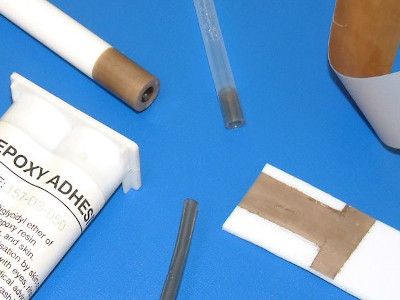bespoke fabrications
fluoroplastic chemical etching
Fluoroplastics are known for their non-stick properties. However, we can offer a chemical etching service for all fluoropolymers, so they can be easily and safely bonded.
The chemical etching treatment changes the surface finish by altering the polymers properties, making them very suitable for bonding with most adhesives, such as epoxy resins, polyurethanes, silicone RTVs.
Our chemical etching process is ideal for use with our fluoropolymer tubing and heat shrink sleeving, especially in FEP, PFA and PTFE for roll covers or rubber hose lining applications.
We can chemically etch the surface of PTFE, FEP, PFA, PVDF, E-CTFE, ETFE and other fluoropolymer tubing, heat shrink sleeving and films.
How does the chemical etching process work?
The chemical etching process causes a reaction between the fluorine molecules in the surface of the material and the sodium solution.
The fluorine molecules are stripped away from the carbon backbone of the fluoropolymer, which leaves a deficiency of electrons around the carbon atom.
Once exposed to air, hydrogen, oxygen molecules and water vapour restore the electrons around the carbon atom. This results in a group of organic molecules that allow adhesion to take place.
What does a chemically etched material look like?
After the chemical etching process has been completed the surface of the FEP, PFA, PTFE or fluoropolymer is darkened to varying shades of brown.
The darkness of the etched surface is not an indication of how good the surface is. As you usually get a variation in the depth of colour of the chemically etched surface.
How do you store chemically etched products?
Chemically etched material should be kept wrapped and in the dark as UV can breakdown the etched surface.
The etched surface will also want to continually replace its electron deficiency and so will take molecules from the air, as it does this the surface becomes less suitable for adhesion.
Can you control the application of the etch to certain surfaces?
Yes, in most cases customers only require the inside or outside surface of the material to be treated. However, we can offer ID and OD for a set length, ID or OD only, and ID and OD.
Areas can be masked off to ensure the etch is only present in the area to be bonded.
Does the chemical etching process affect the materials properties?
No. The chemical etching process only changes the very top layer of the fluoropolymer surface; therefore, all the other excellent material properties remain the same.

Learn more
A guide to fluoropolymer etching: What is chemical etching?
If you're looking for a material which can withstand extreme temperatures and maintain its integrity, but you need to attach it to another material, then fluoroplastic etching is the solution.
Bonding fluoroplastics to other surfaces using chemical etching
Chemical etching is very useful in that it allows the intrinsic qualities of fluoropolymers products (such as heat resistance and a non-stick texture) to be maintained.


